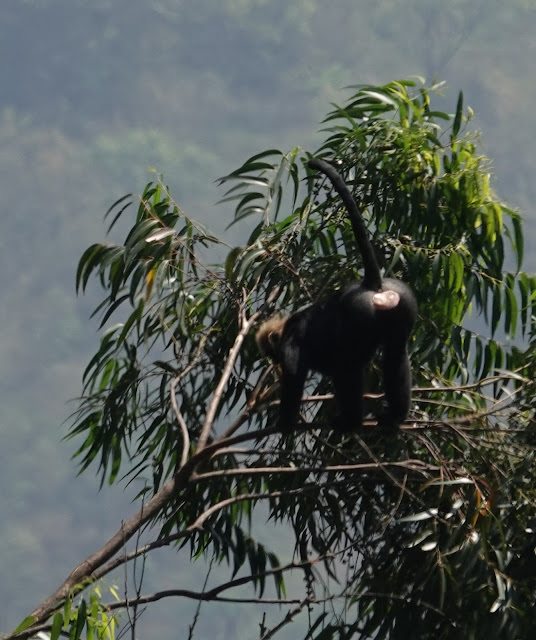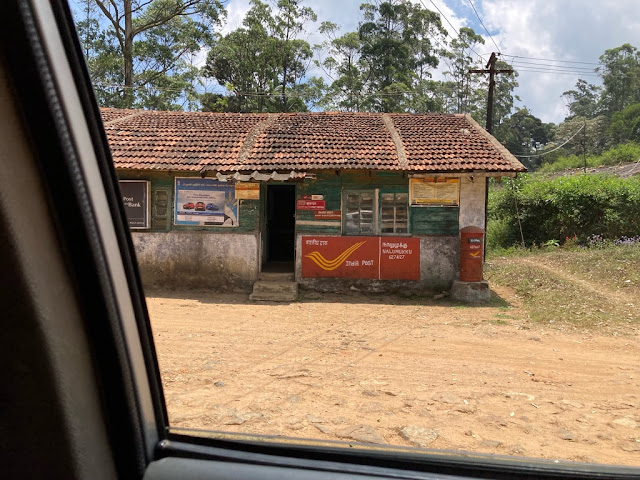Our Talakona trip reacquainted me with all sorts of monkey business. Bonnet macaques (Macaca radiata), everywhere in the camp, but not in the forests! The forests belonged to the Grey Langurs. It was fascinating to see this clear division between the omnivorous macaques and the leaf-eaing langurs.
In the same way. it was only MNS members of the Homo sapiens who seemed to go into the forests around - others stayed in camp!
It is the tuft of hair on the head that has led to their naming, I learnt.
| The macaque children also enjoyed the slides. |
.jpeg) |
| Photo by Baskar. It is a beautiful camp area, with a river running though it, and the tall riverine trees, so majestic! |
Under these trees, we witnessed many an interesting macaque interaction. As Tara walked along cheerfully chocolate in hand, a cheeky juevnile came and snatched at her hand, and as Bhuvanya told her to drop it, the monkey continued to pursue her...until chased away by the others, leaving Tara alarmed and shocked.
.jpeg) |
| Photo by Baskar. These were the rooms used by us ladies, all the balconies had grill protection from the monkeys, which emerged and swarmed the place when the tourists congregated. |
It was like a regular jungle gym experience to see them clambering up and down the bars and stair cases. Our dining area was also "caged" - we were within the cage, and the monkeys were out looking in on us. They seemed especially fond of puris. The morning when we had puris for breakfast, there were half a dozen monkey babies on the bars looking in, trying to make eye contact, make sad faces, cooing sounds, and actually beg for morsels. I was so astonished to see this learned behaviour. The bigger males, were on the roof, banging on the tin and making a god awful racket.
On my return, I came across this article, which more or less sums up what we saw: Novel ‘begging’ behaviour observed in bonnet macaques at Bandipur
 |
| Photo by Baskar. The men's dorm was set back at the far end of the camp space, with lovely wooded walking trails behind it. |
 |
| The little stream that was the life force of the area, and created the riverine ecosystem on either side. There were huge wild mango trees and Shorea species. Arjuna and Elephant apple as well. |
 |
| The temperature in the camp under the tall trees was significantly lower than when we went say 500m away, where it became more scrub-like rocky, and dry. |
 |
| Rajaram captured the kingfisher pair (Alcedo atthis), and the one with the orange lower mandible is likely the female. |
 |
| Near the check dam, the cement wall was a favourite perch for the monkeys, they would sit and preen, sun bathe, meditate, groom, fight, love, beg, play and explore here. |
"Having learned to thrive in a wide range of habitats, the bonnet macaque (macaca radiata) is highly visible throughout India’s southern peninsula. The scrappy bonnet macaque’s ability to live commensal with humans presents perhaps its greatest vulnerability: although the species appears abundant and at ease among humans, recent studies suggest its numbers may be declining faster than previously thought and conflicts with humans further plague this resourceful Asian monkey.Diet
The bonnet macaque spends much of his time inhabiting temples and other urban places where he can readily consume human food. Although he prefers fruits and plant materials, he’s an omnivore and will resourcefully rummage for nourishment in nearby houses, food stalls, gardens, and trash piles. Sometimes, tourists will find entertainment in feeding the monkeys, making the foraging work all the easier. Pale-bellied bonnet macaques and other forest-dwelling bonnet macaques eat fruits, soil, insects, and sometimes small invertebrates and reptiles.
Consuming high concentrations of fruits, plant materials, and certainly human foods can upset even the most robust of digestive systems, but the bonnet macaque appears to have a way to alleviate indigestion, nausea, and diarrhea. A study conducted in the Marakkanam Reserve Forest of southern India found that bonnet macaques ate the soils of termite nests, known as termitaria, which are rich in kaolin and smectite. The combination of these materials, when consumed, mimics the mineralogy of eko, an African remedy for stomach ailments, and Kaopectate™, a western anti-diarrheal preparation."
This macaque is picking termites of the tree. Another one, having ingested something it did not like, was making puking sounds.
Their climbing skills are remarkable even at a young age.
Two Alpha Male incidents
Yuvan observed a grown man hand-feeding Madras mixture to a grown monkey. The man had a pleased look, as he held out his hand with mixture, and the monkey picked it up and ate. This went on for some time, as the man dug into the mixture pack and refilled his hand, and the monkey ate. The man looked gratified and the monkey ate. Until the mixture ran out. At this point, the monkey slapped the man, and stalked off, leaving a shattered and disillusioned man, whose visions of a man-animal bond had just crumbled.
The other incident also involves this same Alpha Male. Prologue - I did not enjoy this caged eating, and so used to take my cup (or rather thimble) of tea, and sit by the water and enjoy the moment. It seemed like the monkeys did not care for tea, and all was peaceful to woman and animal.
Until the time I encouraged Bhuvanya and Minni to also bring their tea cups out and sit on a bench. So a little MNS session was in progress, when the said Alpha Male, came up to Minni on the extreme left and tapped her leg, in a not-very-gentle fashion. Our own not-so-alpha Male Yuvan then stomped his foot in a symbolic gesture of "be off with you". But the real Alpha Male was having none of it, and went up to Yuvan and bared his teeth and let out a growl, causing Yuvan to be taken aback, quite literally. In this fracas, Minni slipped away into the Caged Dining area with her tea, I sat transfixed and Bhuvanya jumped out of her seat. The Monkey Male then turned its attention on me, and I (not wanting to share my tea), quickly drank the last dregs, and also fled, with empty cup. And so ended that monkey encounter.
Langur vs Macaque
I have been a bit obsessed about understanding the difference between the two, and Ravi Chellam pointed me to two major differences - The macaques are omnivrous and have cheek pouches and the langurs are herbivores and have sacculated stomachs.
The link on Old World Monkeys describes it well. There are at least 78 species of Old World monkeys in two subfamilies---the Cercopithecinae (that includes Macaques) and the Colobinae (that includes langurs).
The macaques have cheek pouches - "cheeks that expand rather like those of hamsters to allow the secure temporary storage of food. This is a useful trait for these omnivorous monkeys since they compete with each other for desirable foods and are not inclined to share. Fruit and meat are particularly prized."
The langurs are all herbivores - "lack cheek pouches. They also share in common the fact that they have sacculated click this icon to hear the preceding term pronounced stomachs. That is to say, their stomachs have "saccules," or sack-like compartments, in which bacteria and unusual combinations of enzymes break down plant cellulose, thereby providing more useable calories. Their stomachs also contain more acid than do those of other monkeys. This speeds up digestion but results in delicate stomachs. The Colobinae have unusually long intestines that increase the absorption of nutrients. These are all adaptations to a predominantly low protein, fibrous leaf diet. Not surprisingly, the Colobinae are also referred to as the "leaf-eating monkeys." "
To Feed or not?
Why Feeding Monkeys is Bad for Forests provides an opinion for all sorts of animal feedng, city dogs inclued, and how adoption is the better thing than street feeding. And the problems from various places reflects the same behaviour we saw at Talakona.
"a video from Lopburi, in Thailand, depicted a more apocalyptic scene. It showed hundreds of long-tailed macaques roaming the streets and chasing down any hapless human they could find, hoping to scavenge scraps of food. These monkeys were used to being fed by tourists, and a thriving “animal feeding” industry had sprung up around the temple ruins. With the pandemic-induced lockdowns and travel bans, these easy sources of food vanished. The monkeys, completely dependent on humans, literally took to the streets.......
Near the Buxa Tiger Reserve in West Bengal, residents have expressed their woes about macaques’ looting’ shops and wreaking havoc in fields. These incidents started occurring mainly after the lockdown. Like in Lopburi, the Buxa macaques too were accustomed to being provisioned by tourists.....
Animals fed on high calorie-low nutrient human food such as bread usually are obese, have alopecia, and have increased physiological stress and parasitic loads....As for the macaques, they are far too ecologically resilient to need any help from us."
Earlier this year, the monkey business got so out of hand in Chandigarh that the city put a fine and even imprisonment for anyone caught feeding monkeys.
In my aunt's home at Jayanagar in Bangalore, a large troop of monkeys reside in her garden, and the humn residents all stay within their home, caged and locked in. I know that they used to feed earlier, and not any more.
It is in the wider interest then, for the AP Forest Department to actively discourage monkey feeding, either by disallowing eating and picnicking in their camp site in the outdoors, or by active monitoring and education of the visiting homo sapiens.
































































